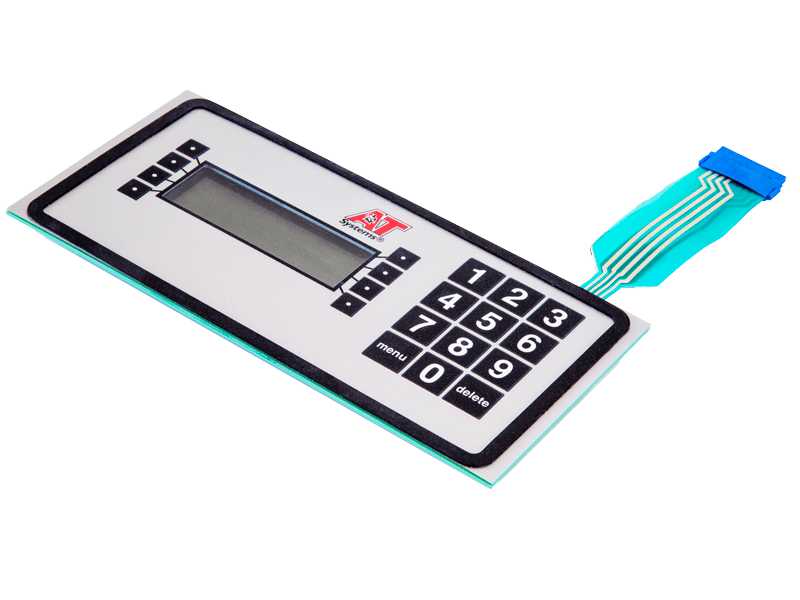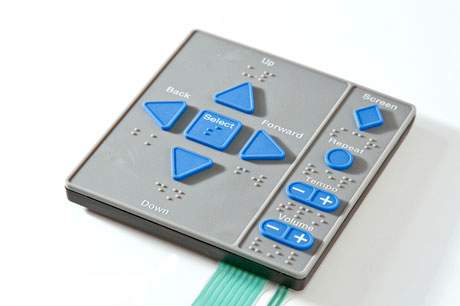Reliable Membrane Switch Manufacturer for High-Quality Control Panels
Reliable Membrane Switch Manufacturer for High-Quality Control Panels
Blog Article
Comprehending the Significance of Membrane Switch in Modern Electronic Devices and Their Applications
Membrane switches over function as a crucial part in modern-day electronics, using an effective user interface for user interaction. Their personalized and lightweight nature makes them suitable for a series of applications throughout diverse markets. Understanding their vital parts and advantages can supply understandings into their growing significance. As innovation remains to advancement, the evolution of Membrane changes questions concerning their future applications and layout developments. What exists in advance in this dynamic area?

What Are Membrane Switches?
Membrane switches are essential components in contemporary electronics, serving as interface that help with communication in between gadgets and customers. These switches contain several layers, consisting of a graphic overlay, an adhesive layer, and a circuit layer, all of which interact to develop a useful and sturdy interface. The layout permits a flat, low-profile remedy that can be customized concerning size, shape, and visual look, making them suitable for different applications, from customer electronic devices to medical tools. The responsive responses offered by Membrane changes boosts customer experience, while their resistance to dust and wetness makes them ideal for testing environments. Membrane switches can include features such as backlighting and printed graphics, additionally broadening their functionality. Their flexibility and effectiveness make them a favored selection in markets where integrity and ease of usage are vital, eventually contributing to the smooth procedure of contemporary electronic devices.
Key Elements of Membrane Changes
While various parts add to the performance of a membrane button, 3 key layers play substantial duties in its design and procedure. The leading layer, usually made from a sturdy polymer, serves as the user interface for customer communication, commonly featuring printed symbols and graphics. Beneath this is the spacer layer, which maintains the essential range between the leading layer and the circuit layer. This spacer layer guarantees that the switch activates just when pressed, stopping unintentional inputs. Ultimately, the circuit layer includes conductive traces that complete the electric circuit when the leading layer is dispirited. These traces can be made from numerous products, consisting of copper or silver. With each other, these components create a reputable and durable device that is portable and functional, appropriate for a vast array of digital applications, from household home appliances to medical tools. Recognizing these essential parts is vital for appreciating the overall performance of Membrane switches.
Benefits of Using Membrane Changes

Membrane Switch Manufacturing Process
Recognizing the Membrane switch production procedure reveals the intricate actions associated with creating these vital parts. The process normally begins with the layout phase, where layouts and specifications are developed using specialized software application. Following this, the graphic overlay is printed on an adaptable substrate, commonly making use of high-resolution printing techniques to assure clearness and precision.Next, the glue layers are used, which offer to bond the various elements together. The circuit layers, made from conductive inks or products, are then published onto a separate substrate. These layers are very carefully lined up and laminated to produce a functional switch.After setting up, the buttons undertake evaluating to confirm performance and toughness. Quality assurance steps are carried out throughout the process to recognize and correct any problems. The completed Membrane buttons are packaged and prepared for circulation, prepared to fulfill the demands of modern-day digital applications.
Applications of Membrane Switches Over in Various Industries
Membrane buttons are increasingly made use of throughout various industries, particularly in medical devices and customer electronic devices. In the clinical area, they provide dependable control interfaces for gadgets that need exact operation. In consumer electronic devices, these switches boost individual interaction by using smooth and responsive interfaces. Receptive Medical Tools Control
Numerous modern clinical devices utilize Membrane buttons for streamlined procedure and enhanced customer interaction. These buttons supply a reputable, durable interface for a selection of applications, consisting of analysis equipment, individual surveillance systems, and medical instruments. Their personalized designs permit certain layouts that can suit the distinct requirements of medical care professionals, ensuring intuitive navigation and effective accessibility to vital functions. Furthermore, Membrane buttons are resistant to pollutants, making them appropriate for clean and sterile settings. The tactile feedback they supply can improve customer self-confidence, reducing the risk of mistakes during essential medical procedures. In general, the assimilation of Membrane buttons in clinical devices considerably adds to enhanced functional performance and person security in health care setups.
Customer Electronics Interfaces
In the domain name of official statement consumer electronics, Membrane buttons play a crucial role in enhancing customer interfaces throughout a large range of devices. These buttons are indispensable to products such as push-button controls, microwaves, and gaming consoles, offering a efficient and straightforward interface. Their layout enables for a seamless combination of graphics and functionality, making it possible for makers to create smooth, modern-day appearances without jeopardizing usability. Membrane switches are additionally understood for their longevity, commonly enduring extensive use and direct exposure to different environmental conditions. Additionally, they can include features like backlighting and tactile comments, more improving the user experience. As customer needs for innovative yet user-friendly interfaces grow, Membrane changes remain to be a crucial element beforehand electronic gadget capability.
Design Factors To Consider for Membrane Changes
Creating reliable Membrane switches requires mindful interest to numerous elements that affect both functionality and user experience. One important factor to consider is the selection of products, as they can affect resilience, responsive comments, and aesthetic charm. Picking an appropriate adhesive is important for guaranteeing lasting adhesion and resistance to ecological factors.In enhancement, the layout and layout of the switch need to accommodate individual interaction, with button sizes and spacing enhanced for simplicity of usage. The incorporation of graphics and labeling need to focus on quality and exposure under various illumination conditions.Consideration of electric qualities, such as actuation pressure and switch level of sensitivity, will certainly boost the responsiveness of the Membrane switch. The style should fit producing processes to assure cost-effectiveness and timely production. Overall, a well-balanced design improves both the customer and the performance experience of Membrane buttons in contemporary electronics.

Future Trends in Membrane Switch Modern Technology
As technology continues to progress, Membrane switches are positioned to integrate brand-new developments that will boost their functionality and application in various fields. One significant fad is the unification of long lasting and flexible materials, which will boost the lifespan and dependability of these buttons. Enhanced surface appearances and personalized graphics are likewise anticipated, enabling even more user-friendly individual interfaces.Moreover, the integration of clever innovation, such as touch-sensitive surfaces and haptic responses, is expected to improve individual interaction, making Membrane switches over more responsive and appealing. Furthermore, advances in printed electronics will enable much more complex circuitry within thinner profiles, better increasing layout possibilities.Sustainability will likewise play an essential function in future growths, as manufacturers discover eco-friendly products and manufacturing advice processes. On the whole, these trends will assure that Membrane changes stay appropriate and vital in an interconnected and significantly digital world.
Regularly Asked Inquiries
Just How Do Membrane Changes Compare to Typical Mechanical Buttons?
Membrane switches offer benefits over standard mechanical buttons, consisting of decreased size, lighter weight, and improved toughness. They generally give a sealed surface, boosting resistance to dust and moisture, making them perfect for diverse applications.
What Products Are Frequently Utilized in Membrane Switch Building?

Can Membrane Switches Withstand Extreme Environmental Conditions?
Membrane switches can stand up to severe ecological problems, depending upon their layout and products. High-quality buildings often include sturdiness against temperature variations, moisture, and exposure to chemicals, making them appropriate for different demanding applications throughout markets.
How Much Time Do Membrane Switches Over Commonly Last Prior To Failure?
Membrane changes commonly display a life-span varying from 1 to 10 million actuations, relying on variables such as use regularity, environmental conditions, and making high quality. Regular upkeep can expand their durability and operational dependability substantially.
Are Membrane Switches Customizable for Details Applications?
Membrane buttons are without a doubt adjustable for certain applications. They can be tailored in performance, dimension, and design, enabling makers to meet distinct individual requirements and improve product looks while maintaining operational performance and durability. Membrane buttons are crucial parts in modern electronic devices, serving as customer interfaces that facilitate communication between customers and devices. The responsive feedback provided by Membrane changes improves customer experience, while their resistance to dust and moisture makes them suitable for challenging environments. The unification of graphics and labeling should focus on clarity and visibility under various lighting conditions.Consideration of electrical features, such as actuation pressure and button level of sensitivity, will certainly boost the responsiveness of the Membrane button. Boosted surface area textures and customizable graphics are additionally prepared for, allowing for even more instinctive user interfaces.Moreover, the combination of smart modern technology, such as touch-sensitive surfaces and haptic feedback, is anticipated to enhance customer interaction, making Membrane changes much more interesting and receptive. Membrane switches deal advantages over standard mechanical switches, including decreased size, lighter weight, and enhanced durability.
Report this page